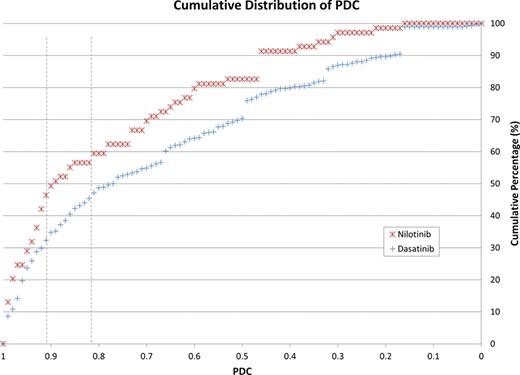Abstract
Abstract 3437
The recommended treatment option for patients diagnosed with chronic myeloid leukemia (CML) who do not achieve hematological or cytogenetic response to first-line imatinib therapy is to switch to one of the two new BCR-ABL tyrosine kinase inhibitors, nilotinib or dasatinib. Both drugs appear to be efficacious; however, there are no direct comparisons for treatment adherence between nilotinib and dasatinib. Analysis of adherence may reveal whether these two drugs are being used as intended and how adherence issues may potentially affect clinical outcomes. Previously, higher imatinib adherence was associated with significantly lower utilization of resources and costs. (Wu EQ, et al. Curr Med Res Opin. 2010;26:61-69.) The objective of this retrospective study was to compare adherence associated with second-line nilotinib versus dasatinib in a real-world setting.
Two administrative claims databases were combined (MarketScan and Ingenix Impact, 01/2002-12/2008) to identify patients diagnosed with CML (ICD-9 code 205.1x) who had received ≥1 prescription for either nilotinib or dasatinib. Patients were required to have continuous enrollment ≥1 month prior to and after the index date. The index date was defined as the first prescription for nilotinib or dasatinib. Patients were followed for up to 6 months from the index date to the earliest of the termination of health care plan enrollment, or end of data availability. Treatment adherence was measured by the proportion of days covered (PDC) and compared using generalized linear models. PDC was calculated as the sum of the days of supply for nilotinib or dasatinib, divided by the number of calendar days in the study period (i.e., up to 6 months after the index date). Unadjusted average PDCs were compared between nilotinib and dasatinib users using Wilcoxon sum-rank tests. Multivariate regressions were controlled for age, gender, CML disease complexity, any adverse event at baseline, CML year of diagnosis, comorbidities, and bone marrow or stem cell transplant at baseline. Medication possession ratios and discontinuation rates, defined as a treatment gap ≥30 days, were also evaluated.
A total of 521 patients receiving a second-line TKI (452 dasatinib and 69 nilotinib) were studied. Patients had a mean age of 57 years, and all other characteristics were similar between the 2 cohorts with the exception that patients in the dasatinib cohort had a longer mean follow-up period compared to those in the nilotinib cohort (161.6 days vs 141.9 days; P = 0.0105). Patients in the dasatinib cohort were less adherent to their therapy compared to nilotinib patients. The PDC (mean ± standard deviation) over the study period was 0.79 ± 0.23 for nilotinib patients and 0.69 ± 0.28 for dasatinib patients. After adjustment, dasatinib patients were estimated to have a 0.096 lower PDC value (approximately 13% lower) compared with nilotinib patients (P = 0.0086). A greater proportion of dasatinib users had a PDC <0.8 and PDC <0.9 (Figure). A statistically significant difference in medication possession ratios at 180 days was also observed; 0.75 ± 0.33 for dasatinib and 0.85 ± 0.27 for nilotinib (P = 0.029). Discontinuation rates were similar between the two drugs with an adjusted hazard ratio (HR) of 1.03 (HR >1 indicates that dasatinib users have a greater discontinuation rate than nilotinib users; 95% confidence interval, 0.63–1.69; P = 0.8981).
CML patients treated with second-line nilotinib had significantly better adherence during the 6-month study period than patients treated with second-line dasatinib as defined by the PDC. The medication possession ratio was also greater for nilotinib-treated than dasatinib-treated patients; however, discontinuation rates were similar between the two treatment groups. Although adherence may be related to a greater safety profile as adverse events may disrupt treatment, head-to-head comparisons of the drugs as second-line therapy for CML have not been performed. Further research is necessary to understand and define all factors, including safety, involved in affecting treatment adherence for nilotinib and dasatinib patients.
Guerin:Analysis Group, Inc.: Employment. Bollu:Novartis: Employment. Guo:Novartis: Employment. Griffin:Novartis: Consultancy, Research Funding. Yu:Analysis Group, Inc.: Employment. Wu:Analysis Group, Inc.: Employment.
Author notes
Asterisk with author names denotes non-ASH members.


This feature is available to Subscribers Only
Sign In or Create an Account Close Modal